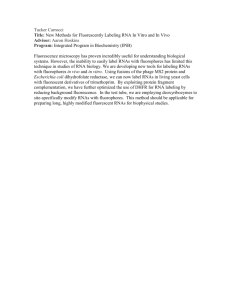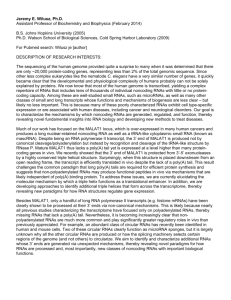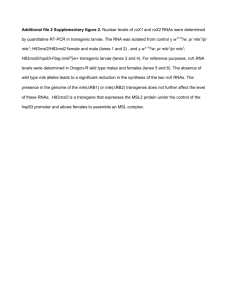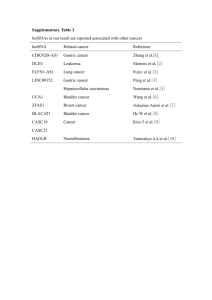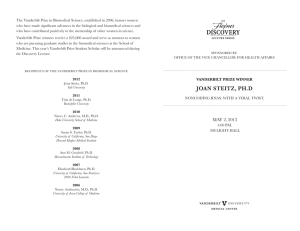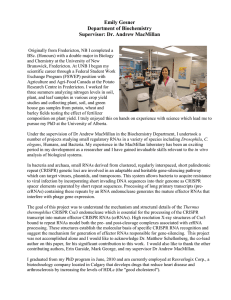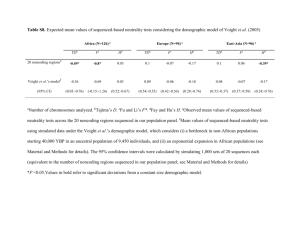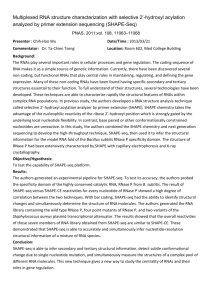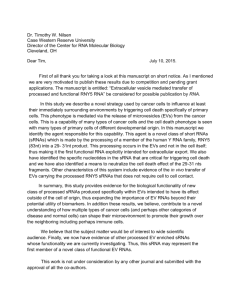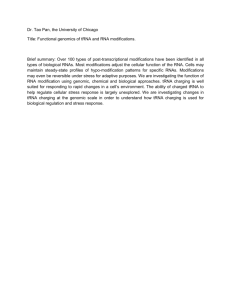Biol 270, Seminar in Genetics
advertisement
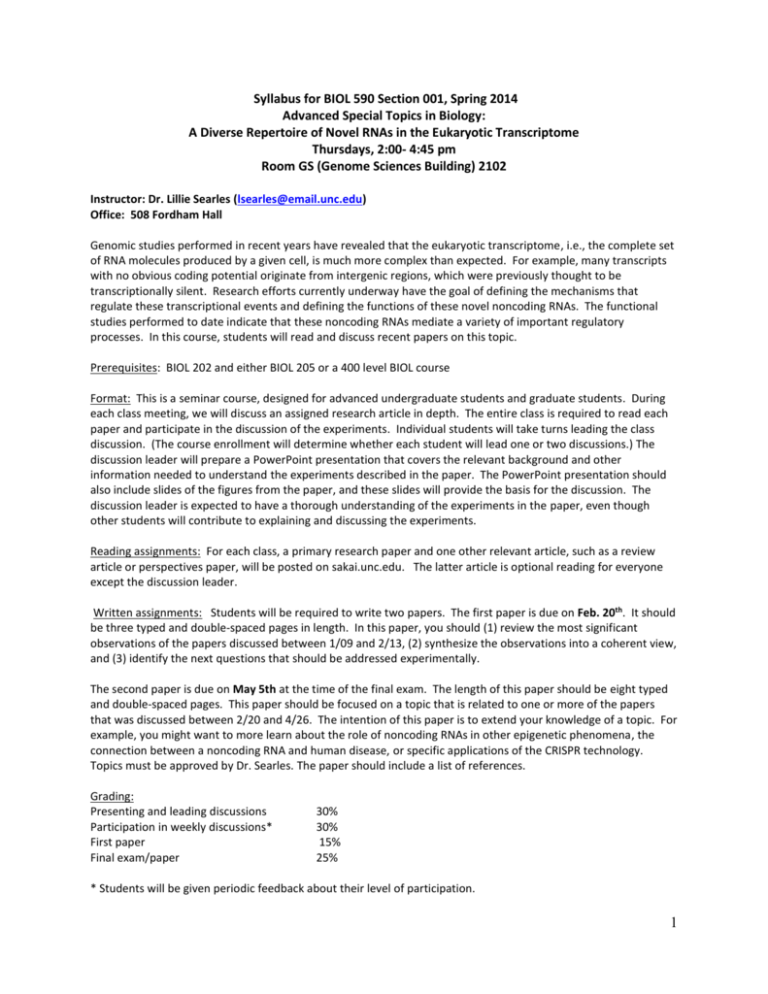
Syllabus for BIOL 590 Section 001, Spring 2014 Advanced Special Topics in Biology: A Diverse Repertoire of Novel RNAs in the Eukaryotic Transcriptome Thursdays, 2:00- 4:45 pm Room GS (Genome Sciences Building) 2102 Instructor: Dr. Lillie Searles (lsearles@email.unc.edu) Office: 508 Fordham Hall Genomic studies performed in recent years have revealed that the eukaryotic transcriptome, i.e., the complete set of RNA molecules produced by a given cell, is much more complex than expected. For example, many transcripts with no obvious coding potential originate from intergenic regions, which were previously thought to be transcriptionally silent. Research efforts currently underway have the goal of defining the mechanisms that regulate these transcriptional events and defining the functions of these novel noncoding RNAs. The functional studies performed to date indicate that these noncoding RNAs mediate a variety of important regulatory processes. In this course, students will read and discuss recent papers on this topic. Prerequisites: BIOL 202 and either BIOL 205 or a 400 level BIOL course Format: This is a seminar course, designed for advanced undergraduate students and graduate students. During each class meeting, we will discuss an assigned research article in depth. The entire class is required to read each paper and participate in the discussion of the experiments. Individual students will take turns leading the class discussion. (The course enrollment will determine whether each student will lead one or two discussions.) The discussion leader will prepare a PowerPoint presentation that covers the relevant background and other information needed to understand the experiments described in the paper. The PowerPoint presentation should also include slides of the figures from the paper, and these slides will provide the basis for the discussion. The discussion leader is expected to have a thorough understanding of the experiments in the paper, even though other students will contribute to explaining and discussing the experiments. Reading assignments: For each class, a primary research paper and one other relevant article, such as a review article or perspectives paper, will be posted on sakai.unc.edu. The latter article is optional reading for everyone except the discussion leader. Written assignments: Students will be required to write two papers. The first paper is due on Feb. 20th. It should be three typed and double-spaced pages in length. In this paper, you should (1) review the most significant observations of the papers discussed between 1/09 and 2/13, (2) synthesize the observations into a coherent view, and (3) identify the next questions that should be addressed experimentally. The second paper is due on May 5th at the time of the final exam. The length of this paper should be eight typed and double-spaced pages. This paper should be focused on a topic that is related to one or more of the papers that was discussed between 2/20 and 4/26. The intention of this paper is to extend your knowledge of a topic. For example, you might want to more learn about the role of noncoding RNAs in other epigenetic phenomena, the connection between a noncoding RNA and human disease, or specific applications of the CRISPR technology. Topics must be approved by Dr. Searles. The paper should include a list of references. Grading: Presenting and leading discussions Participation in weekly discussions* First paper Final exam/paper 30% 30% 15% 25% * Students will be given periodic feedback about their level of participation. 1 Date Topic / Paper Title Broad Topic: Mechanisms that limit the accumulation of unwanted noncoding transcripts 1/09 Introduction to the phenomenon of pervasive transcription 1/16 Transcriptome-wide binding sites for components of the Saccharomyces cerevisiae non-poly(A) termination pathway: Nrd1, Nab3, and Sen1 1/23 Transcriptome surveillance by selective termination of noncoding RNA synthesis 1/30 U1 snRNP determines mRNA length and regulates isoform expression 2/06 Promoter directionality is controlled by U1 snRNP and polyadenylation signals 2/13 CBC-ARS2 stimulates 3'-end maturation of multiple RNA families and favors cap-proximal processing Broad Topic: Roles performed by various noncoding RNAs 2/20 First writing assignment is due 2/20 eRNAs promote transcription by establishing chromatin accessibility at defined genomic loci 2/27 Tandem stem-loops in rox RNAs act together to mediate X chromosome dosage compensation in Drosophila 3/06 A role for neuronal piRNAs in the epigenetic control of memory-related synaptic plasticity 3/13 Spring Break—no class 3/20 The microRNA miR-34 modulates ageing and neurodegeneration in Drosophila 3/27 No class 4/03 Natural RNA circles function as efficient microRNA sponges 4/10 The imprinted H19 lncRNA antagonizes let-7 microRNAs Topic: A recent adaptation of RNA-mediated regulation for experimental purposes 4/17 Repurposing CRISPR as an RNA-guided platform for sequence-specific control of gene expression 4/26 CRISPR-mediated modular RNA-guided regulation of transcription in eukaryotes 5/5 noon Final paper is due. 2
